- Home
- The Summer Garden
- Summer Bulbs
Summer Bulbs Add Magic and a Touch of the Exotic to the Garden
There is something
special about summer bulbs. The
daffodils, hyacinths, and tulips of spring may be finished for the year, but
some of the best beauties strut their stuff in the summer. Think of the gorgeous blues of agapanthus, the
tropical look of caladiums and elephant ears, the intoxicating scents of
Oriental lilies, or the delight of surprise lilies blooming on their naked
stems in late summer.
It is easy to add a few of these beauties to your garden in containers to decorate the patio or deck or in beds for color and drama. All of them grow from true bulbs, corms, rhizomes or tuberous roots. Most of them are planted in the spring for summer bloom.
Here are some of great choices to consider for summer bulbs.
Acidanthera bicolor, see Gladiolus callianthus
Agapanthus africanus, lily-of-the-Nile or African lily, Zones 7-10. Agapanthus have some of the most divine blues in the horticultural world. Just to gaze upon them in the heat of summer seems lower the temperature. Available in white, all shades of blue from icy to near black and blue-and-white combinations, to purple, agapanthus is indispensable for the summer border or containers. Varieties include ‘Albus,’ white; ‘BlackJack™’,‘ purple; ‘Blue Ice,’ white with blue at the base; ‘Blue Yonder’ blue; ‘Gold Strike’ blue and white striped flowers and white and green variegated foliage; ‘Neverland,’ sky blue with golden variegated foliage; ‘Queen Mum,’ white with blue; and ‘Storm Cloud,’ violet-blue.’
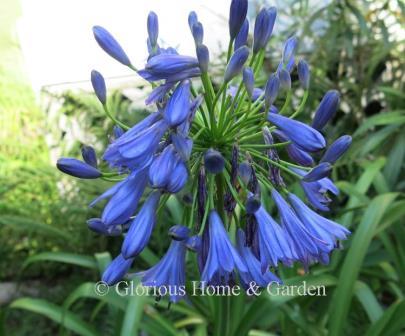 Agapanthus africanus
Agapanthus africanus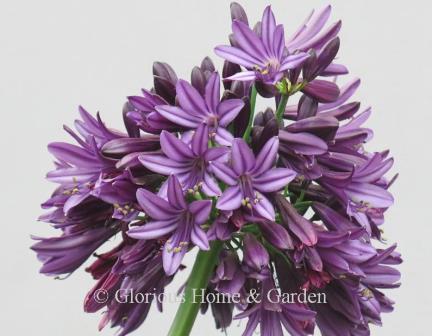 Agapanthus 'Blackjack™'
Agapanthus 'Blackjack™'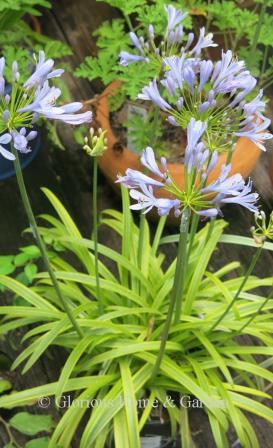 Agapanthus 'Neverland'
Agapanthus 'Neverland'Alliums---Ornamental Onions
Allium cernuum, wild nodding onion, lady's leek, Zones 4-8. This is a charming native wild onion with a distinctive nodding flower umbel of white, pink, or purple bells dangling from curved stalks. It is edible, and like all alliums, the leaves have an unmistakably oniony odor when crushed. Grow in a sunny, well-drained location. Great for pollinators. Deer resistant.
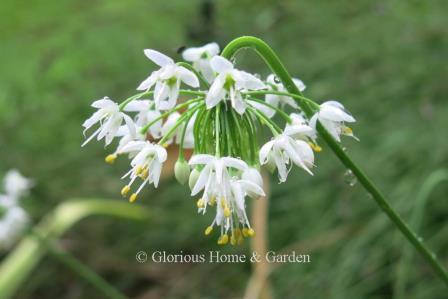 Allium cernuum
Allium cernuumAllium “Millenium,’ ornamental onion, zones 4-9. The 2018 Perennial Plant of the Year®, Allium ‘Millenium’ is a fabulous summer perennial. After a winter dormancy, a basal clump of narrow, grass-like leaves arises in spring followed by bloom scapes to about 14-20” topped with globular, rose-purple flowers in summer. A great plant, and an excellent choice for a butterfly garden.
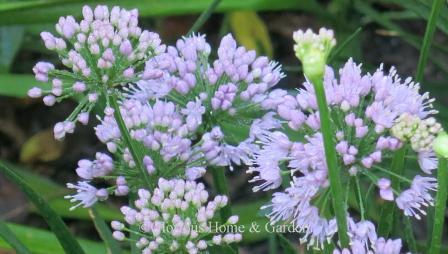 Allium 'Millenium'
Allium 'Millenium'Allium senescens ‘Pink Planet, ornamental onion, Zones 4-8. Another great summer-flowering ornamental onion, ‘Pink Planet’ produces spherical flowerheads of a soft pink rising to 18 to 24.” Plant in a sunny, well-drained location and watch the bees and butterflies flock to it.
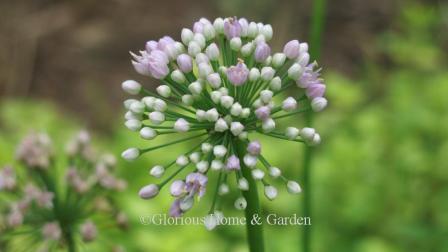 Allium senescens 'Pink Planet'
Allium senescens 'Pink Planet'Allium sphaerocephalon, drumstick allium, Zones 4-8. This is a very striking allium for the
mid-border as it can grow from 1 1/2' to 3' in height. The deep purple color is rich and combines
well with other colors like white, cream, yellow and peach. Lovely combined with daylilies.
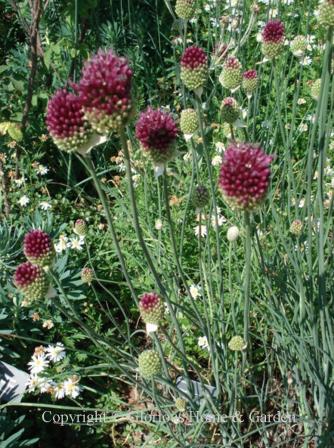 Allium sphaerocephalon
Allium sphaerocephalonAllium ‘Summer Drummer,’ Zones 4-8. Extend the allium season with this beauty which blooms in June to August (depending on location). It will add drama to the border with its large globes (as much as 8”) of purple and white blooms while towering from 4 to 6 ft.
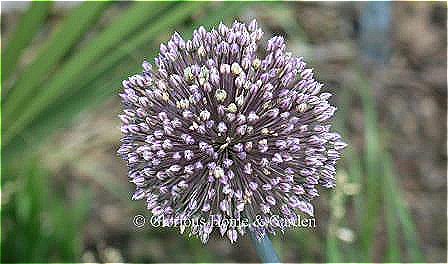 Allium 'Summer Drummer'
Allium 'Summer Drummer'X Amarcrinum, crinodonna, Zones 7-10. Crinodonnas are crosses between crinum lilies and Amaryllis belladonna. These elegant plants make dramatic statements in the summer border, especially for the South. ‘Fred Howard’ is a lovely one with pale pink fragrant flowers that reblooms until frost.
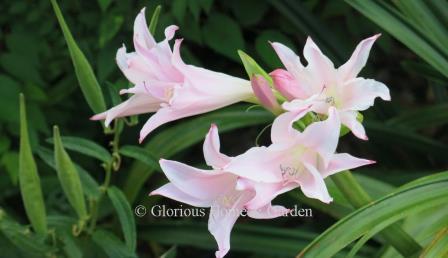 X Amarcrinum 'Fred Howard'
X Amarcrinum 'Fred Howard'Begonia boliviensis, Bolivian begonia, Zones 9-10. Wonderful for hanging baskets, these begonias with their dangling bell-like blooms and long narrow leaves are summer performers extraordinaire. As the species name indicates, these begonias are native to Bolivia and Argentina. The flowers come in sun-drenched colors of white, yellow, orange, pink, salmon, and red. It is very easy to grow Bolivian begonias. Plant the tubers in a good quality well-draining mix designed for indoor plants, and place in an area that gets bright, but not direct sunlight—a covered patio or screened porch is ideal. Water when the soil is dry, but not so often that it becomes soggy. For a maximum flower display, feed every few weeks through spring and summer and begin to taper off as fall begins. To overwinter above Zone 9, dig the tubers before the first frost, allow to dry, removed the old foliage and store in a cool dry place until replanting after danger of frost is past. Alternatively, you can bring them indoors and treat as a house plant in a sunny window. Bolivian begonias are one of the most rewarding plants you can grow for summer color. Cultivars include Bossa Nova® Rose,’ rose pink; Million Kisses® ‘Devotion,’ red; ‘San Francisco,’ salmon; and ‘’Santa Barbara,’ white.
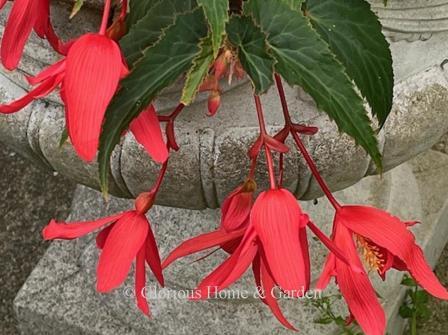 Begonia bolieviensis Bossa Nova® 'Rose'
Begonia bolieviensis Bossa Nova® 'Rose'Begonia grandis, hardy begonia, Zones 6-9. This begonia, unlike most of its family, is unusual for its hardiness. It makes a fine ground cover for partial to shady situations with its handsome heart-shaped leaves. Pink blooms appear in mid-summer to fall and self-seed prolifically.
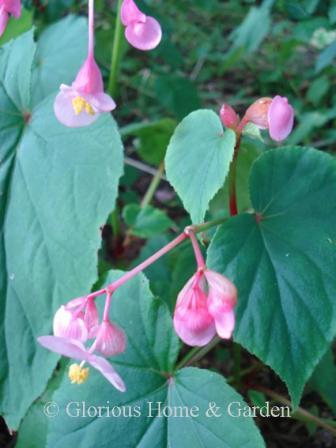 Begonia grandis
Begonia grandisBelamcanda chinensis, blackberry lily—See Iris domestica.
Caladium, angel wings, Zones 10-11. Big tropical-looking caladiums are fun to grow in containers or the shady border for splashes of color. One of the best summer plants for a shady location. Plant them after danger of frost is past and soil temperature has warmed up. As these tubers are not winter hardy above Zone 10, they must be dug and stored before frost. Dig up the tubers at the end of the season, remove the foliage and allow them to dry for a few days, then store in a cool dry location, but not lower than 55.° There are many great varieties with fascinating color combinations of white, pink, red and green. Some white varieties include ‘Candidum,’ ‘Moonlight,’ and ‘White Christmas.’ For pinks try ‘Apple Blossom,’ ‘Pink Splash,’ or ‘Spring Fling.’ If dramatic red is what you crave, look for ‘Brandywine,’ ‘Frieda Hemple,’ or ‘Red Flash.’ Some lovely ones that combine white with pink and green include ‘Carolyn Whorton,’ ‘Miss Muffet,’ and ‘Tapestry.’
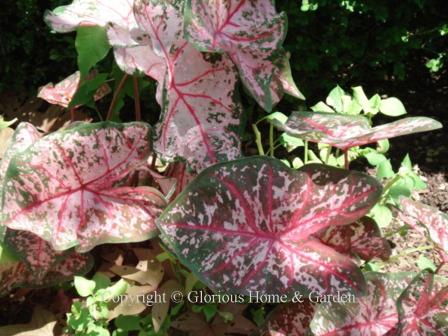 Caladium 'Carolyn Whorton'
Caladium 'Carolyn Whorton'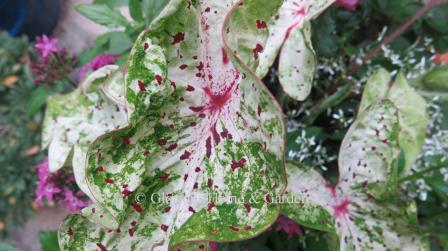 Caladium 'Miss Muffet'
Caladium 'Miss Muffet'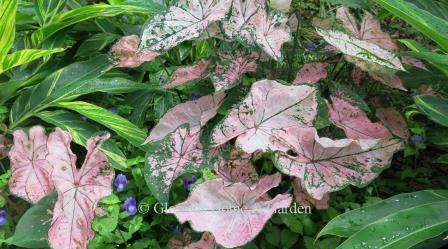 Caladium 'Pink Splash'
Caladium 'Pink Splash'Canna x hybrida, canna lily hybrids, Zones 7-10. I must admit that I’ve never grown cannas probably because they need full sun and space and I am in short supply of both. But I do love their exotic air and tropical flair, so I may just have to try one or two of the dwarf varieties in containers. Cannas love full sun, hot weather and rich, well-drained soil. They can overwinter in the ground in Zones 7-10, but north of Zone 7 they must be dug and stored for the winter. Cannas are an excellent summer bulb to choose for spectacular accents in the border or containers. There are tall and dwarf varieties. The flower colors are bright and sumptuous in white, yellow, orange, pink or red. The leaves can be just as eye-catching as the flowers, being large and often offering bold contrasts in shades of green, variegated stripes, red, or dark burgundy.
A few tall varieties include ‘Australia,’ orange-red with dark burgundy-black leaves, 48-60” tall; ‘Eureka,’ yellow with green foliage, 48-60”; ‘Pretoria,’ orange with green and yellow variegated leaves, 48-78”; ‘Red King Humbert,’ red, with bronzy-maroon foliage; 60-72”.
Some dwarf ones include ‘Apricot Dream,’ soft apricot with pink centers, 3-4’ tall; Cannova® ‘Yellow,’ bright yellow, 3-4,’ Louis Cottin,’ yellow with dark burgundy foliage, 24-36”; ‘Lucifer,’ red with yellow edge, 32-36”; ‘Valentine,’ soft pinkish-red, 30”.
Canna lilies are great hummingbird attractants.
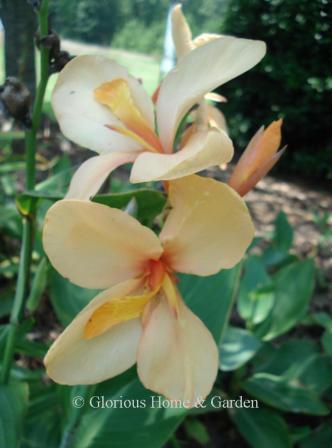 Canna 'Apricol Dream'
Canna 'Apricol Dream'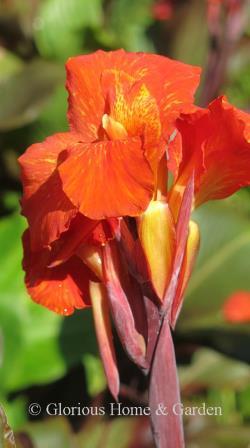 Canna 'Austrailia'
Canna 'Austrailia'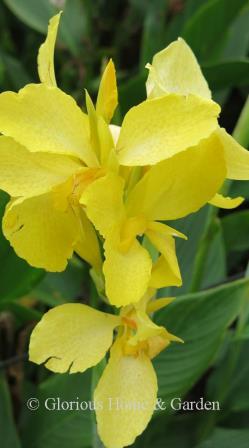 Canna Cannova® 'Yellow'
Canna Cannova® 'Yellow'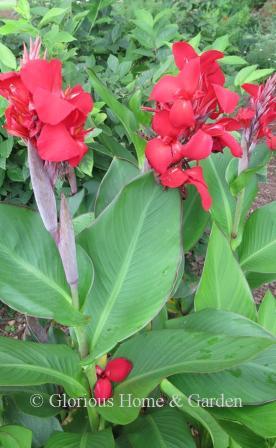 Canna x generalis 'Valentine'
Canna x generalis 'Valentine'Colocasia esculenta, elephant ears or taro, Zones 8-11. Welcome to the jungle! What is better to create a tropical feeling in the summer especially around a patio or pool than elephant ears? Huge heart-shaped leaves, as much as 24” x 18,” are dramatic and exotic. Elephant ears love moisture, and can even be planted in a pot in a pond. If planted in garden soil, do provide adequate moisture, rich soil, full to part sun and frequent feeding to keep these huge leaves healthy and luxuriant. In Zones 7b and below, elephant ears can over overwintered outdoors well mulched. In colder areas the tubers should be dug up, allowed to dry, then packed in vermiculite or perlite and kept in an area that does not freeze. Lots of exciting new selections are available in facinating colors and patterns. ‘Blue Hawaii’ has green leaves with purple veins; ‘Diamond Head’ has glossy almost black leaves; ‘Illustris’ has dark purple leaves veined and edged in green; ‘Mojito’ sports green leaves blotched with purple markings; ‘White Lava’s’ green leaves have a white vein down the center and a purple spot at the heart.
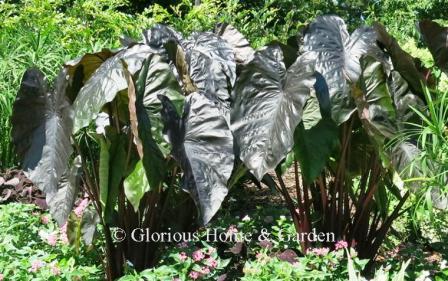 Colocasia esculenta 'Diamond Head'
Colocasia esculenta 'Diamond Head'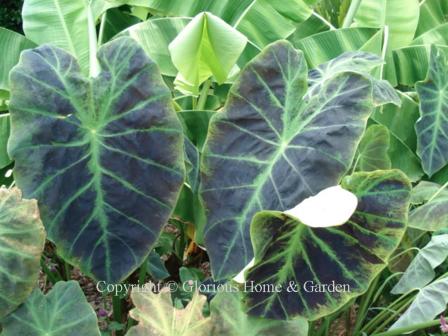 Colocasia esculenta 'Illustris'
Colocasia esculenta 'Illustris'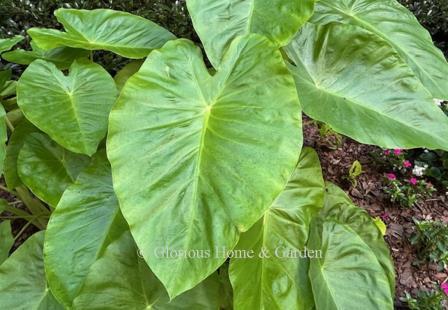 Colocasia esculenta 'Maui Gold'
Colocasia esculenta 'Maui Gold'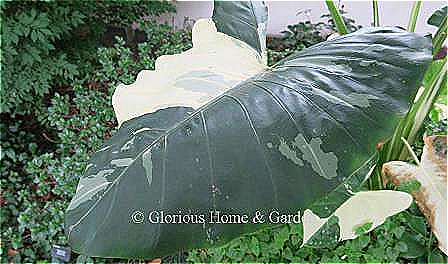 Colocasia esculenta 'Milky Way'
Colocasia esculenta 'Milky Way'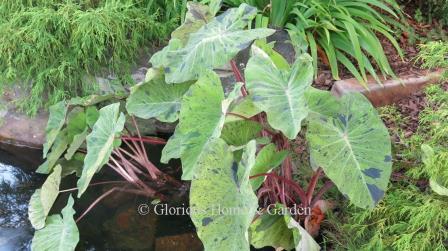 Colocasia esculenta 'Mojito'
Colocasia esculenta 'Mojito'Crinum americanum, American spider lily or Southern swamp lily, Zones 8-11. Native to wetlands of the Southeastern U.S., this spider lily can adapt to garden conditions given adequate consistent moisture. It can also be grown in containers making it easier to bring indoors before frost where not winter-hardy. Tall 24-36” naked stalks arise in summer from a base of long strappy evergreen leaves. Fragrant white flowers with long narrow petals and red stamens open in an umbel of typically six flowers.
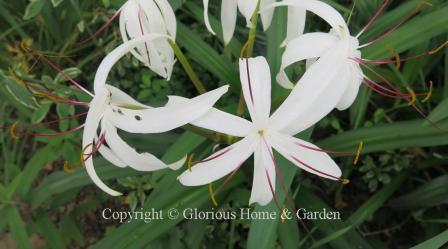 Crinum americanum
Crinum americanumCrinum hybrids, crinum lilies, Zones 7-10. Crinums are gorgeous summer bulbs that are a mainstay of the Southern summer border and never fail to draw attention—and most have a delicious fragrance. They love sun and require a lot of space as they grow into quite large, long-lived clumps. There are many hybrids available in white and lovely shades of pink and rose like ‘Elizabeth Traub,’ dark rose pink; ‘Ellen Bosanquet,’ deep rose; ‘Pink Mystery.’ pale pink; ‘Pink Perfume,’ pink buds open to pure white; C. x herbertii commonly called the “milk and wine” lily for its pink and white candy cane stripies; and C. x digweedii ‘Royal White,’ white with a narrow pale pink stripe down the center of each petal.
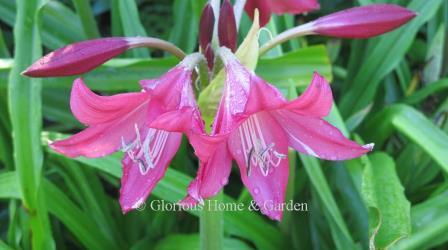 Crinum 'Elizabeth Traub'
Crinum 'Elizabeth Traub'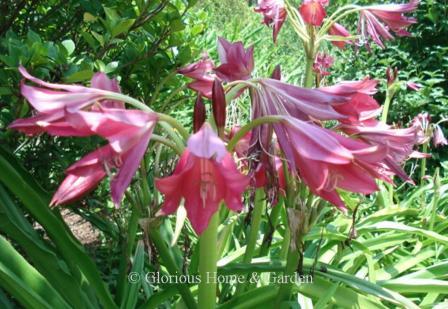 Crinum 'Ellen Bosanquet'
Crinum 'Ellen Bosanquet'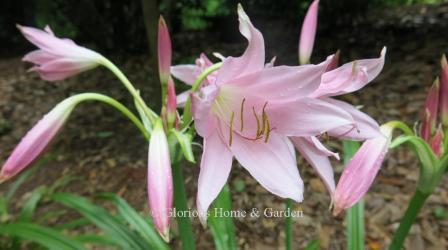 Crinum 'Pink Mystery'
Crinum 'Pink Mystery'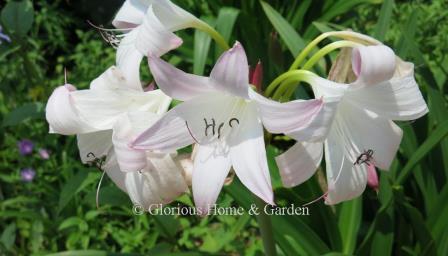 Crinum 'Pink Perfume'
Crinum 'Pink Perfume'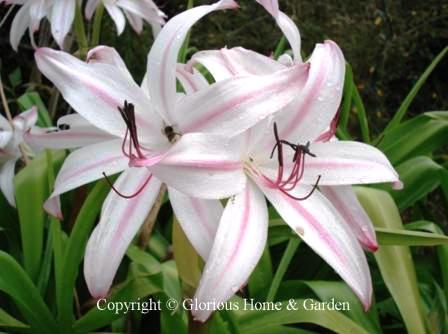 Crinum x digweedii 'Royal White'
Crinum x digweedii 'Royal White'Crocosmia x crososmiiflora, hybrid crocosmia or montbretia, Zones 6-10. Need a summer bulb for a pop of color in the border? Try crocosmias! These gladiolus relatives throw graceful, arching stems in hot colors of yellow, orange and scarlet red. Each stem, as the flowers open one by one from the bottom up, makes a fabulous cut flower for arrangements. Easy to grow, crocosmias only ask for full sun, good drainage and a little fertilizer to put on their show. Some great crocosmias to try include ‘Honey Angels,’ yellow; ‘Lucifer,’ scarlet; ‘Mistral,’ orange.
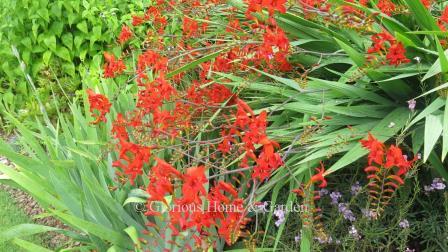 Crocosmia 'Lucifer'
Crocosmia 'Lucifer'Eremurus himalaicus, foxtail lily or desert candle, Zones 6-9. For an effect to rival foxgloves and delphiniums in the garden, try foxtail lilies. These summer bulbs add structure and dramatic excitement to the garden. Easy to grow, they only need full sun and good drainage to thrive—but give them plenty of room by planting about one per square foot. Display them against a dark background at the back of the border and plant in groups for best effect. Since the flowering stalks can rise from 4’ to as much as 9’, they may need staking to protect from strong winds. Colors range from white to yellow, apricot, orange and rose. Varieties include ‘Cleopatra,’ orange; ‘Himalayan,’ white; ‘Macarena,’ apricot; and E. stenophylus, yellow.
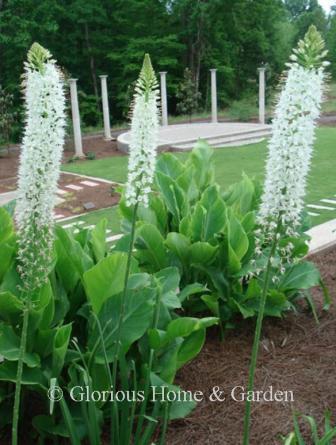 Eremurus himalaicus
Eremurus himalaicusEucomis autumnalis, pineapple lily, Zones 7-10. Pineapple lilies are such fun! They look for all the world like pineapples with their tufts of leaves and individual white flowers arranged all around the stem. They do best in full sun, but mine have done pretty well in a semi-shady location. They may be called “autumnalis,” but mine bloom in mid-summer in 7b.
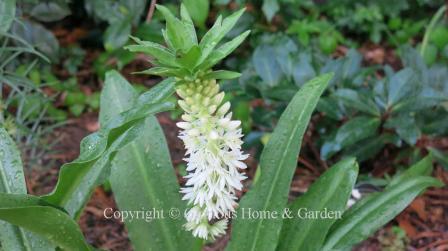 Eucomis autumnalis
Eucomis autumnalisEucomis comosa, pineapple lily, Zones 7-10. This species of pineapple lily differs from E. autumalis by having reddish edges to the pineapple “tuft,” reddish stems, and reddish eyes to the flowers, and they bloom a little earlier. ‘Sparkling Burgundy’ has even darker burgundy coloration. ‘Twinkle Stars’ has pink flowers and dark foliage.
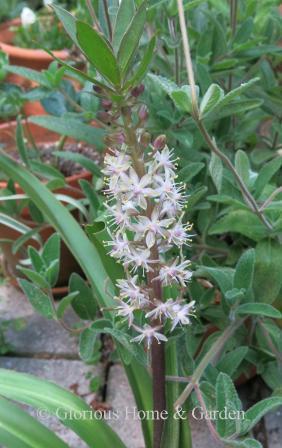 Eucomis comosa
Eucomis comosa Eucomis comosa 'Sparkling Burgundy'
Eucomis comosa 'Sparkling Burgundy'Gladiolus callianthus ‘Murielae’, Abyssinian gladiolus or peacock orchid (formerly Acidanthera), Zones 7-10. This, to me, is one of the most elegant of the summer bulbs. Fragrant pure white flowers open wide to reveal a deep purple throat atop 2-3’ stalks in late summer. Corms should be planted in spring in full sun after frost danger is past. Above Zone 7, the corms should be dug in the fall and stored in 55° to 60° temperatures in perlite, vermiculite, dry peat moss, or even a paper bag. In Zone 7 and below, the corms can remain in the ground, but benefit from digging up every few years before frost when the foliage has yellowed, and replanting in the spring. Remove the old shriveled corm from the base of the new corm that has formed on top of it and separate the baby cormels that develop around the mother corm. These can be planted separately to develop for a couple of years until they reach flowering size.
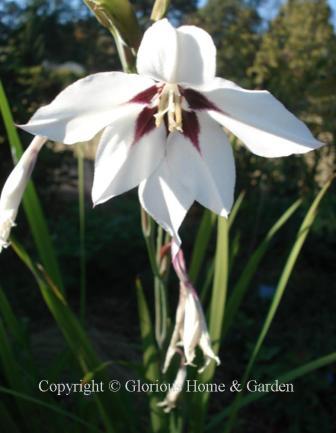 Gladiolus callianthus ‘Murielae’
Gladiolus callianthus ‘Murielae’Gladiolus dalenii, parrot or African gladiolus, Zones 6-9. Gladiolus dalenii is a hardy species from Africa occurring in shades of yellow, orange and red. ‘Boone’ is a hybrid in a lovely golden apricot color reaching 48.” Hardy, fast-multiplying, and deer-resistant to boot!
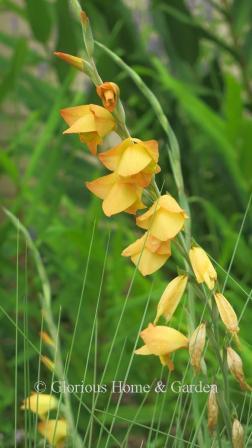 Gladiolus dalenii 'Boone'
Gladiolus dalenii 'Boone'Gladiolus x hortulanus, hybrid gladiolus, Zones 8-10. Old-fashioned gladioli are making a comeback because they are easy to grow, are great cut flowers for arrangements, and come in a very wide variety of colors making them excellent additions to the summer border. Glads grow from corms and are best planted in spring for summer bloom. In fact, one can plant some every few weeks for a succession of bloom all summer. Corms should be lifted before frost and stored overwinter in perlite, vermiculite or peat moss in a cool, but not freezing area. Plant them out again in spring after danger of frost is past.
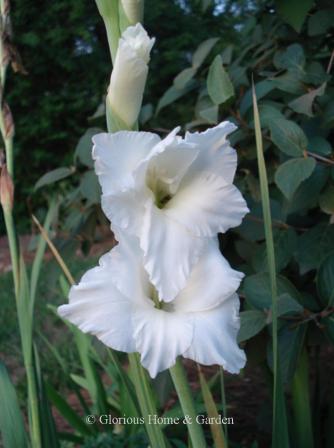 Gladiolus x hortulanus 'White Friendship'
Gladiolus x hortulanus 'White Friendship'Gladiolus primulinus ‘Atom,’ hardy gladiolus, sword lily, Zones 5-10. An oldie but a goodie from 1946, ‘Atom’ is a striking glad in pure velvety red edged in white—a real standout in the garden.
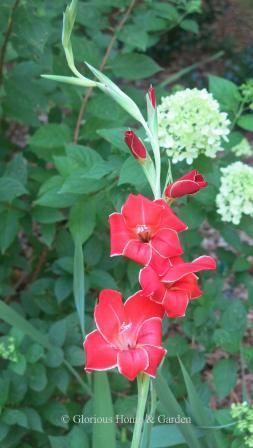 Gladiolus primulinus 'Atom'
Gladiolus primulinus 'Atom'Gladiolus tubergenii, hardy gladiolus, sword lily, Zones 7-10. Another hardy gladiolus, G. tubergenii, makes a lovely addition to the summer perennial border. While smaller than the common hybrid glads, they add a certain charm to the garden—indeed the variety ‘Charm’ is well-named.
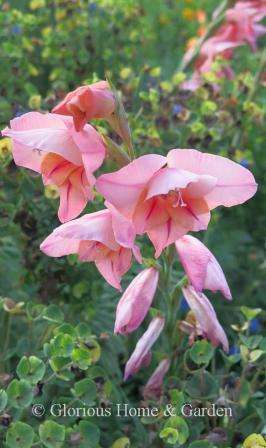 Gladiolus tubergenii 'Charm'
Gladiolus tubergenii 'Charm'Gloriosa superba, glory lily or climbing lily, Zones 8-10. Give this summer bulb something to climb on and stand back! Exotic and easy to grow, gloriosa lilies love sun and well-drained soil and are virtually pest-free. They will climb onto anything near them—a fence, trellis, post, or neighboring plant. The swept-back flaming red and yellow petals give the flowers a shooting star or meteor effect.
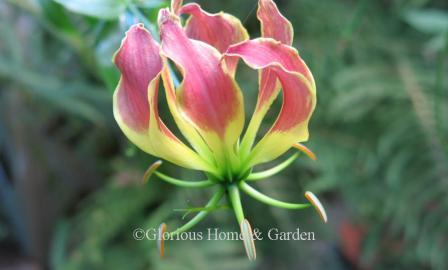 Gloriosa superba 'Rothschildiana'
Gloriosa superba 'Rothschildiana'Plant of the Month
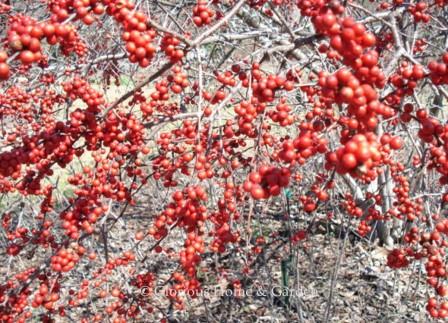
Ilex verticillata
Winterberry holly
Updated new USDA Plant Hardiness Zone Map 2023.